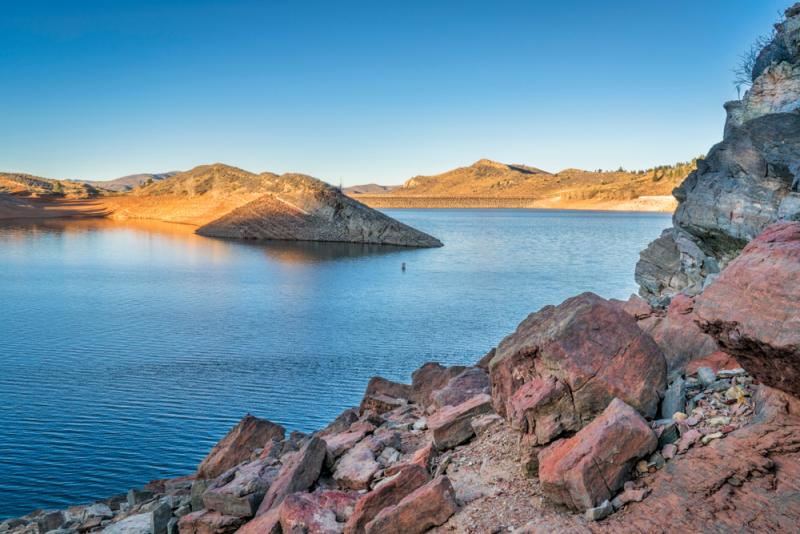Q&A: Environmental Expert Weighs in On Colorado’s Megadrought

Colorado’s legendary snowpack has long been of critical importance to cities and states on both sides of the Continental Divide and due south all the way to Mexico. It’s an essential resource for the winter sports industry, of course, but also for farmers on the plains, city dwellers on the Front Range and wildlife across the state.
Thanks to persistent drought and a changing climate, the state’s snowpack is declining, and Colorado finds itself in the same predicament facing cities and countries across the globe, which, by dint of necessity, are changing how they collect, use and conserve water.
Michael Kerwin, director of the University of Denver’s Environmental Science Program, has led field-based coursework and research into climate change and drought across the Rocky Mountains, the American Southwest and South Africa, where, in 2017, Cape Town nearly became the world’s first major city to run out of water. (Through coordinated conservation efforts, Day Zero—when the taps were to be shut off—was avoided.) He joined the DU newsroom to discuss how drought and a warmer climate are likely to shape Colorado’s future—and what we can do to prepare for it. The conversation has been condensed and edited for clarity.
How is climate change affecting precipitation across Colorado?
Climate change has altered the intensity and frequency of precipitation in Colorado. At higher elevations, there has also been a shift in the type of precipitation, with rainfall occasionally replacing snow. Moving forward, powerful, high-precipitation events will become more common in addition to extended periods of reduced precipitation. For example, the Front Range experienced historic rainfall and flooding in September 2013 as the North America Monsoon extended north of its normal September position. This perturbation was likely caused by enhanced summer warming in the intermountain west.
Meanwhile, all of Colorado has dealt with severe to extreme drought (megadrought) on and off for 22 years. Blaming climate change for the current drought conditions, however, is problematic, because at least four other megadroughts impacted Colorado and the western USA over the past 2,000 years. But drought conditions today are more damaging to ecosystems and human needs for surface water because of corresponding record high temperatures. These enhance evapotranspiration and decrease soil moisture. As a result, Colorado’s current global warming-enhanced drought is unprecedented in the recent geologic past and of great concern moving forward.
What does Colorado’s declining yearly snowpack mean for the environment and natural ecosystems?
The thickness, areal extent and persistence of mountain snowpack is declining in Colorado because of increasing year-round temperatures and changes in the timing and type of precipitation. Warmer temperatures have also caused an earlier start to the spring runoff season and reduced the length of time that winter snowfall survives in Colorado’s high mountains. Reduced snowpack will decrease stream discharge needed for agriculture, and industrial and domestic water uses.
Over time, diminished snowpack and stream runoff can also upend natural ecosystems by lowering infiltration. This decreases soil moisture, causing plant mortality and allowing insects (like pine bark beetles) to harm or kill the dominant vegetation in subalpine and montane communities. In some forested communities, wildfires can be more severe because of drought stress, leading to a higher probability of destructive crown fires.
What will Colorado’s industries—from snow sports to agriculture—need to do to adapt to prolonged drought?
Adapting to climate change in Colorado, including long-term drought coupled with warmer temperatures, will require political resolve, government and corporate investments in technology and education, and fundamental changes in how residents live with a less-certain supply of freshwater.
In terms of snow sports and agriculture, what worked in the past is no longer sustainable. Winter recreation, for example, has already been impacted by climate change. Depending on the location, skiable days have declined by 20–30%, with diminished snow quality. In addition, artificial snow making is now ubiquitous even at the highest elevation ski resorts.
Winter sport enthusiasts can look south to New Mexico for a prelude of what is to come as temperatures continue to warm. In formerly reliable locations like Sandia Peak, Ski Apache and Pajarito Mountain, skiing is now limited to the coldest portion of the winter, and temporary closures are common during times of minimal snowfall.
As for agriculture, in Colorado this sector is by far the largest consumer of stream runoff and remains mostly dependent on low-technology center pivot irrigation systems. Thus, the utilization of gray water, drip irrigation and soil water monitoring should allow farms and ranches to survive drought, but only if funding is readily available.
Are there similarities between drought in the American West and the Day Zero water crisis in South Africa?
The current drought in the western USA in not comparable to the 2015–2017 drought in South Africa, called Day Zero. The Day Zero crisis was caused by a 50–70% reduction in winter rainfall over three years. This caused Cape Town to nearly run out of water in their reservoir system on “Day Zero.” This event garnered international attention because Cape Town, unlike Denver, did not have alternative sources of freshwater. Nor does the city have high mountains nearby that collect winter snowfall. Instead, they were almost 100% dependent on storing rainfall in nearby reservoirs. Had Cape Town been able to use groundwater or desalinated ocean water, the Day Zero crisis would have been diminished.
The western USA megadrought started in 2000 and has become an unprecedented crisis for the Colorado River Watershed. However, over the past 22 years, there have been several amorously wet seasons (and even individual years) that temporarily improved the water supply locally. In addition, the resources in place to store and deliver water to residents are diverse (involving snowmelt, rainfall, groundwater, recycled water and desalinated water); geographically widespread (from the Pacific Ocean to the Rocky Mountains); technologically advanced; and, until now, effective. In contrast, poor water management practices and infrastructure deficiencies in Cape Town worsened the rainfall deficit.
What can we do to ensure future water access for the residents, industries and ecosystems of Colorado?
In the United States, laws are already in place to protect aquatic ecosystems even during the most severe drought. Outside of these narrow aquatic and riparian zones, however, plants and animals will be forced to adapt, migrate or be outcompeted over time in response to diminished streamflow, snowpack and warmer temperatures.
As for humans, all of us—residents, industry, agriculture—must reduce water use. State leaders need to acknowledge that water is a finite resource. Growth initiatives must consider current and future water challenges. In Denver, where outdoor irrigation consumes about 50% of annual domestic water use, non-native turf grass needs to be removed and replaced with native plants.
Colorado’s largest cities needs to provide financial incentives for customers to make these changes. Water bills need to increase, but with safeguards for low-income customers. Water recycling—including “toilet to tap” initiatives that have been successfully implemented in Perth, Australia, and San Diego, California—must become commonplace. In short, Colorado no longer has sufficient water to support overconsumption.
Compared to other parts of the world, Colorado is in an enviable position to withstand climate change and prolonged drought. This is because the state still receives vast amounts of snowfall, has technology in place for trans basin water diversions and much room for improved conservation. Now is the time, however, for our leaders to acknowledge that the current pace of growth is unsustainable in terms of our water supply and to double down on efforts aimed at education and conservation.
To learn more about water issues in the Centennial State and the West, tune in to RadioEd’s conversation about the Colorado River Compact.



